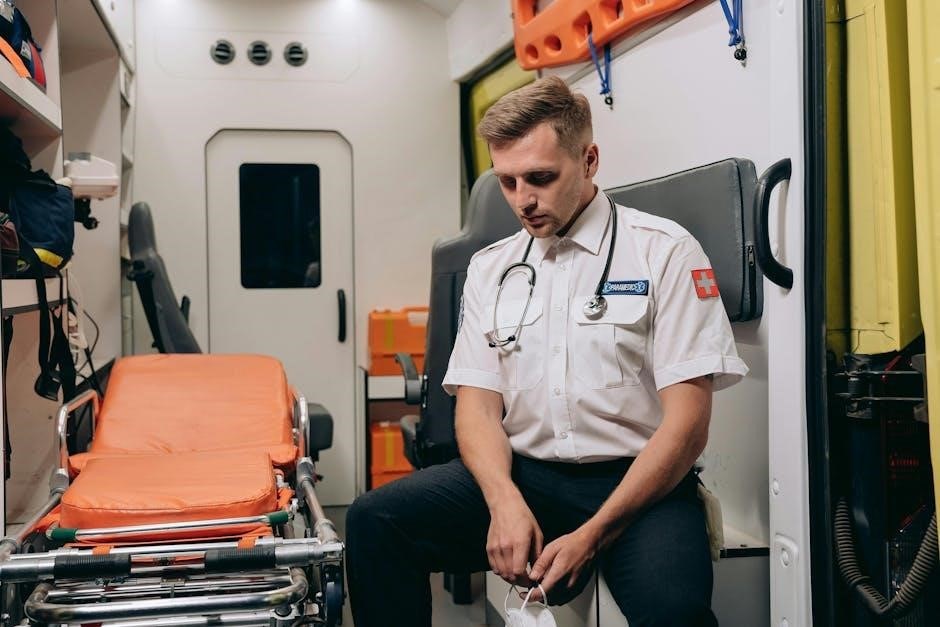
first aid usmle step 2 cs pdf
The First Aid for the USMLE Step 2 CS is a high-yield resource designed to help medical students master the Clinical Skills exam․ It offers case simulations, practical strategies, and essential clinical skills, making it a trusted guide for success․
Overview of the USMLE Step 2 CS Exam
The USMLE Step 2 CS (Clinical Skills) exam evaluates medical students’ ability to interact with patients, perform physical exams, and communicate effectively․ It involves standardized patient encounters, requiring applicants to demonstrate clinical reasoning and documentation skills․ The exam focuses on common medical scenarios, testing both diagnostic and interpersonal abilities․ While the exam was discontinued in 2021, its format and content remain relevant for clinical skills development․ The First Aid USMLE Step 2 CS PDF provides high-yield information, case simulations, and practical strategies to excel in such clinical settings, making it a valuable resource for mastering patient-care skills․
Importance of First Aid Resources in USMLE Preparation
First Aid USMLE Step 2 CS PDF is a cornerstone in exam preparation due to its concise, high-yield format․ It condenses complex clinical scenarios into digestible content, helping students focus on critical areas․ The resource provides real-life patient cases, practical exam strategies, and essential checklists, ensuring comprehensive preparation․ Its emphasis on effective time management and clinical reasoning aligns with exam requirements․ Additionally, the guide’s focus on communication and physical exam techniques enhances interpersonal and diagnostic skills․ As a trusted tool, it bridges gaps between theoretical knowledge and practical application, making it indispensable for achieving success on the USMLE Step 2 CS․

Understanding the First Aid USMLE Step 2 CS PDF
The First Aid USMLE Step 2 CS PDF is a comprehensive guide tailored for medical students preparing for the Clinical Skills exam․ It combines case simulations, practical strategies, and essential clinical techniques, offering a structured approach to mastering patient encounters and communication skills․ The guide is regularly updated to reflect exam changes, ensuring relevance and effectiveness․ Its clear layout and high-yield content make it an invaluable resource for students aiming to excel in their clinical exams․
Key Features of the First Aid USMLE Step 2 CS Guide
The First Aid USMLE Step 2 CS Guide is renowned for its high-yield content and practical approach․ It includes detailed case simulations, focusing on common patient scenarios and challenging clinical situations․ The guide emphasizes the ICE (Identify, Confirm, Explore) framework, providing structured strategies for patient interactions․ Additionally, it offers comprehensive physical exam techniques for various organ systems, ensuring a thorough preparation for clinical encounters․ Updated editions incorporate feedback from recent test-takers, ensuring relevance and accuracy․ The guide’s clear, concise format and focus on exam-specific skills make it an essential tool for success in the USMLE Step 2 CS․
How to Use the First Aid PDF for Effective Studying
Maximizing the First Aid USMLE Step 2 CS PDF involves a structured approach․ Begin by skimming through the entire document to understand its layout and key sections․ Focus on high-yield topics and case simulations, which are crucial for exam success․ Use the ICE framework to practice patient interactions, ensuring you can identify, confirm, and explore clinical issues effectively․ Regularly review physical exam techniques and practice them on friends or colleagues․ Supplement your study by cross-referencing with other resources and taking practice exams to reinforce learning․ Organize your study schedule to cover all sections systematically, ensuring comprehensive preparation for the exam․
Exam Preparation Strategies
Effective strategies include prioritizing high-yield topics, practicing active learning techniques, and using mnemonics․ Regularly review and simulate exam conditions to build stamina and familiarity with the format․

Time Management Tips for the USMLE Step 2 CS
Mastering time management is critical for the USMLE Step 2 CS․ Allocate 1-2 minutes for patient history, 3-4 minutes for the physical exam, and 1-2 minutes for documentation․ Prioritize high-yield symptoms and avoid unnecessary details․ Use mnemonics like OPQRST for pain assessment and SOAP for note-writing․ Practice under timed conditions to simulate exam pressures․ Stay calm and systematic, ensuring each step is efficient without compromising accuracy․ Effective time management enhances clinical performance and confidence during the exam․
High-Yield Topics to Focus On
Focus on high-yield topics in the First Aid USMLE Step 2 CS PDF, such as common patient presentations like chest pain, shortness of breath, abdominal pain, and neurological deficits․ Master history-taking and physical exams for these conditions․ Pay attention to pediatric, geriatric, and psychiatric cases, as they are frequently tested․ Practice differential diagnoses and patient note documentation․ Review high-yield mnemonics and clinical pearls to streamline your approach․ Prioritize time management and systematic patient assessment to ensure comprehensive yet efficient evaluations․ These topics are emphasized in the guide, making them crucial for achieving a high score on the exam․
Practicing with Sample Cases
The First Aid USMLE Step 2 CS PDF provides realistic case simulations, enabling you to practice and refine your clinical skills․ Work through common patient scenarios to improve your readiness for the exam․
Common Patient Cases in the USMLE Step 2 CS
The First Aid USMLE Step 2 CS PDF covers a wide range of common patient cases, such as hypertension, diabetes, and respiratory issues․ These cases mirror real-life clinical encounters, helping you practice history-taking and physical exams․ The guide includes scenarios involving abdominal pain, chest pain, and neurological symptoms, among others․ Each case provides high-yield pearls and practical tips, ensuring you are well-prepared for the exam’s clinical challenges․ By mastering these cases, you’ll improve your ability to identify and manage common conditions effectively․
Challenging Scenarios and How to Approach Them
The First Aid USMLE Step 2 CS PDF addresses complex patient encounters, such as non-English speaking patients and those with multiple chronic conditions․ These scenarios require strong communication and prioritization skills․ The guide provides strategies for handling difficult cases, emphasizing patient-centered communication․ It also offers tips for remaining calm under pressure and systematically approaching each case․ By practicing these high-stakes scenarios, you’ll build confidence and improve your clinical decision-making, ensuring readiness for even the toughest exam situations․

Clinical Skills Assessment
The First Aid USMLE Step 2 CS PDF focuses on mastering patient interaction, history taking, and physical exams․ It emphasizes the ICE framework and effective documentation, ensuring comprehensive clinical competence․

Mastering the ICE (Identify, Confirm, Explore) Framework
The ICE framework—Identify, Confirm, Explore—is a cornerstone of clinical skills assessment in the First Aid USMLE Step 2 CS PDF․ It guides students to systematically approach patient encounters, ensuring thoroughness and accuracy․ Identify involves recognizing key symptoms and potential diagnoses․ Confirm requires verifying findings through targeted questions and physical exams․ Finally, Explore encourages deeper investigation into patient history, risk factors, and differential diagnoses․ This structured approach enhances patient interaction, documentation, and clinical decision-making, making it indispensable for exam success․ The guide provides practical examples and case simulations to help students master this framework effectively․

Physical Exam Techniques for Different Systems
The First Aid USMLE Step 2 CS PDF provides detailed insights into physical exam techniques across various systems․ For the cardiovascular system, it emphasizes auscultation of heart sounds and murmurs․ The respiratory system focuses on lung percussion and auscultation for abnormal sounds․ Neurological exams cover cranial nerves, motor strength, and reflex testing․ The abdominal exam includes inspection, auscultation, percussion, and palpation․ Each section offers practical tips to perform these techniques accurately and efficiently, ensuring students master the skills required for the clinical skills exam․ This systematic approach helps build confidence and competence in patient assessment․

Resources and Study Materials

The First Aid USMLE Step 2 CS PDF is complemented by additional tools like flashcards, case guides, and online resources, ensuring comprehensive preparation for the exam․
Additional Tools for USMLE Step 2 CS Success
Beyond the First Aid USMLE Step 2 CS PDF, students can utilize flashcards, case guides, and online platforms for targeted practice․ These tools offer high-yield information, mnemonics, and visual aids to reinforce learning․ Flashcards based on First Aid are particularly useful for quick review and retention․ Additionally, online resources provide realistic patient cases and exam tips, helping candidates master clinical scenarios and time management․ These supplementary materials complement the PDF, ensuring a well-rounded preparation strategy for the USMLE Step 2 CS exam․

The First Aid USMLE Step 2 CS PDF is an essential resource for exam success, offering high-yield content and practical strategies․ By mastering its insights, examinees can confidently approach the clinical skills assessment and achieve their goals․
Final Tips for Achieving Success on the USMLE Step 2 CS

Mastering the First Aid USMLE Step 2 CS PDF is crucial for exam success․ Focus on high-yield topics, practice with sample cases, and refine your ICE framework application․ Time management is key; allocate minutes wisely for each patient encounter․ Simulate real exam conditions during practice to build confidence․ Pay attention to physical exam techniques and patient communication skills․ Review challenging scenarios and common patient cases to improve your approach․ Utilize additional tools like flashcards and study guides to reinforce your knowledge․ Stay calm, organized, and systematic during the exam to ensure optimal performance and achieve your goals․